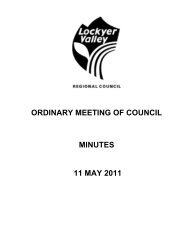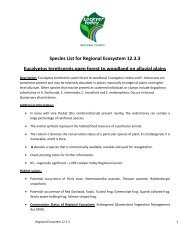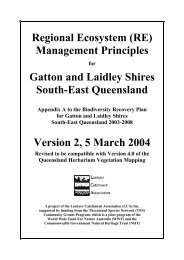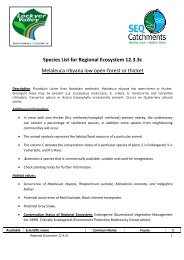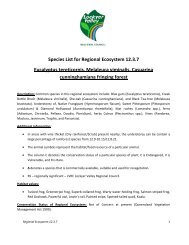Biodiversity Recovery Plan - Lockyer Valley Regional Council
Biodiversity Recovery Plan - Lockyer Valley Regional Council
Biodiversity Recovery Plan - Lockyer Valley Regional Council
You also want an ePaper? Increase the reach of your titles
YUMPU automatically turns print PDFs into web optimized ePapers that Google loves.
• Whether the habitat is necessary for use as corridors to allow the species to move freely<br />
between sites used to meet essential life cycle requirements;<br />
• Whether the habitat is necessary to ensure the long-term future of the species or<br />
ecological community through reintroduction or re-colonisation; and<br />
• Any other way in which habitat may be critical to the survival of a listed threatened<br />
species or ecological community.<br />
The <strong>Biodiversity</strong> <strong>Recovery</strong> <strong>Plan</strong> for Gatton and Laidley Shires, South-East Queensland 2003-<br />
2008 uses the Queensland Environmental Protection Agency (EPA) regional ecosystem<br />
classification system to identify critical habitat. The Queensland EPA report The<br />
Conservation Status of Queensland’s Bioregional Ecosystems highlights the relevance of the<br />
regional ecosystem classification system to the multi-species and local recovery planning<br />
approaches of this recovery plan:<br />
<strong>Regional</strong> ecosystems are an integrated entity derived from landscape pattern, geology<br />
and landform, and vegetation, so as to provide a robust classification for biodiversity<br />
planning that incorporates ecological processes at the landscape scale. This landscape<br />
approach is developed for biodiversity planning because of the paucity of information<br />
on the distribution of biota over much of the State. This classification will be useful for<br />
land use planning and a range of land management activities.<br />
Information on the exact distribution and life cycle requirements of the significant species<br />
and ecological communities covered by this recovery plan is very limited, and will remain<br />
limited for the foreseeable future. This is because of the comparatively large areas of<br />
vegetation remaining in Gatton and Laidley Shires and limits to the resources that can be<br />
realistically allocated for the intensive studies needed to locate every population of every<br />
significant species and to determine all of the life cycle requirements of every significant<br />
species. However, the recovery of significant species and ecological communities can still be<br />
achieved by using the regional ecosystem classification system to identify critical habitat for<br />
significant species and ecological communities, and by identifying management activities<br />
aimed at maintaining and restoring regional ecosystem ecological processes. This is the aim<br />
of the <strong>Biodiversity</strong> <strong>Recovery</strong> <strong>Plan</strong> for Gatton and Laidley Shires, South-East Queensland<br />
2003-2008.<br />
0.0 <strong>Lockyer</strong> Catchment <strong>Biodiversity</strong><br />
<strong>Recovery</strong> Project<br />
The preparation of the <strong>Biodiversity</strong> <strong>Recovery</strong> <strong>Plan</strong> for Gatton and Laidley Shires, South-East<br />
Queensland 2003-2008 was an initiative of the <strong>Lockyer</strong> Watershed Management Association<br />
(LWMA) Inc. - <strong>Lockyer</strong> Landcare Group, which in 2002 merged with the <strong>Lockyer</strong><br />
Catchment Coordinating Committee (LCCC) to form the <strong>Lockyer</strong> Catchment Association<br />
(LCA) Inc.<br />
The recovery plan preparation was a component of the <strong>Lockyer</strong> Catchment <strong>Biodiversity</strong><br />
<strong>Recovery</strong> Project. The project involved recovery planning and on-ground conservation<br />
works and was funded from the Threatened Species Network (TSN) Community Grants<br />
6



